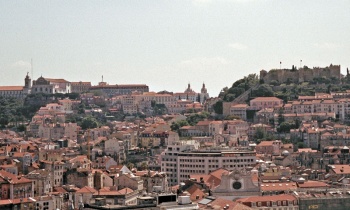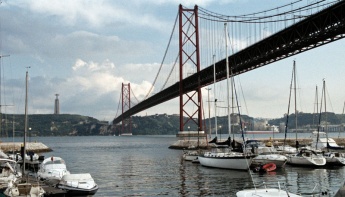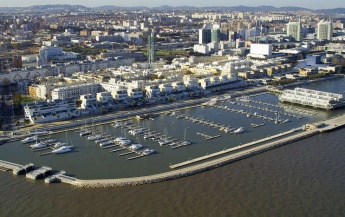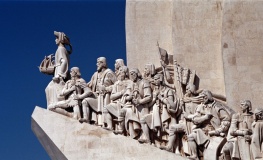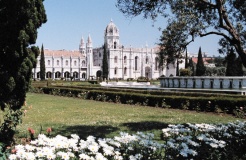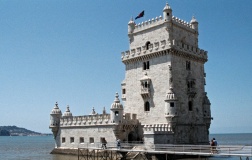Lisbon
From CruisersWiki
| Lisbon Port of Entry
| |
| | |
Lisbon, the capital of Portugal, is situated at 38°42' north, 09°5' west, making it the westernmost capital in mainland Europe. The city occupies an area of 84.8 km2 (33 sq mIs) on the Atlantic Ocean coast where the Rio Tejo (River Tagus) flows into the Atlantic.
Today, Lisbon is a thriving and vibrant city of 565,000 souls with a rich architectural and cultural heritage that is reflected in the inclusion on UNESCO’s World Heritage list of two of its major attractions, the Torre Belem and the Jeronimos Monastery.
Visitors to Lisbon by yacht have the option of berthing at one of the out of town marinas, such as Cascais or Oeiras, and travelling into the city by the excellent train service, or endeavouring to find a berth at one of the busy marinas up the Rio Tejo (River Tagus) in the heart of the city. It’s really a choice between peaceful quiet and noisy convenience.
Charts
- British Admiralty
- 3220
- 3221
- 3222 (Rio Tejo and approaches)
- 3635
- 3263
- Portuguese
- 23202
- 23203
- 24203
- 24204
- 26406
- 26303
- 26304
- 26305
- 26306
- 26307
- 26406
- Imray
- C19
Weather
See Portugal.
Passages
See Portugal.
Communication
Add here VHF channel for coastguard, harbor masters. etc.
Also see World Cruiser's Nets.
From the south - Round Cabo Espichel and steer for 15 miles on a course of 344º. Enter the Rio Tejo between Fort São Julião da Barra on the N shore and the Fort Bugio lighthouse in the channel to the SE.
From the north - Stay one mile off Cabo da Roca and Cabo Rasa. Continue along the coast, entering the Rio Tejo between Fort São Julião da Barra to port on the north shore and the Fort Bugio lighthouse in the channel to the SE.
If entering on the ebb, note that tidal currents can run at 2-3 knots in the river and tend to set to the south onto the shoals east of Fort Bugio lighthouse.
Entrance
Lisbon is a port of entry/exit to Portugal.
See details of marinas below for check-in information.
Berthing
Lisbon boasts a total of six marinas along the north coast of the Rio Tejo (River Tagus). However, the city seems unable to keep pace with the ever-increasing demand for berthing spaces and, as a result, many of the marinas are filled to capacity with local vessels and do not welcome visitors. The marinas in which visitors are most likely to find a berth are (in order of arrival upriver):
- Doca de Alcantayra,
- Doca do Terreiro do Trigo Marina, and
- Marina Parque das Nações.
All of the entrances to these marinas are subject to a greater or lesser extent to the effects of tidal currents, especially on the ebb, and care is needed when maneuvering.
Marinas & Yacht Clubs
The principal Lisbon marinas are - in order of arrival when proceeding upriver:
Doca de Bom Successo
Doca de Belem
Doca de Santo Amaro
Doca de Alcantara
Doca do Terreiro do Trigo
Marina Parque das Nações
Anchorages
The nearest safe anchorage in the Lisbon area is at ![]() Seixal [[Lisbon#Seixal|Seixal]] 38°41.85′N, 09°6.81′W on the south bank of the river. Follow the buoyed channel and anchor where convenient in the pool of Seixal. There are regular ferries from here over to the centre of Lisbon.
Seixal [[Lisbon#Seixal|Seixal]] 38°41.85′N, 09°6.81′W on the south bank of the river. Follow the buoyed channel and anchor where convenient in the pool of Seixal. There are regular ferries from here over to the centre of Lisbon.
Amenities
| Facilities | |
|---|---|
| Water | See marina notes above |
| Electricity | See marina notes above |
| Toilets | ? |
| Showers | ? |
| Laundry | See marina entries |
| Garbage | Bins in all the marinas |
| Supplies | |
| Fuel | See marina notes above |
| Bottled gas | ? |
| Chandlers | See marina notes above |
| Services | |
| Repairs | See marina notes above |
| Internet | See marina entries |
| Mobile connectivity | ? |
| Vehicle rentals | ? |
Provisioning
See marina entries.
Eating out
See marina entries.
Transportation
List transportation (local and/or international.)
Tourism
History
Traces of settlement in the area have been dated back to Neolithic and subsequently Phoenician times, but it was during the Roman era in 205BC that the settlement here was formalized under the title of Olissipo. The town was occupied by Germanic tribes after the fall of Rome in the 5th century AD, then by Moorish invaders in the 8th century. The beginnings of the Portuguese nation date from the town’s capture by a crusading army in 1147 under Alfonso I, who subsequently became the first king of Portugal. Lisbon became the de facto capital just over a century later in 1256. Development followed swiftly, and the first Portuguese University was founded here in 1290 before being later transferred to Coimbra. Most of the famous Portuguese voyages of discovery started from Lisbon during the 15th to 17th centuries, including Vasco da Gama’s renowned expedition to India in 1497, which was commemorated by the endowment of the stunning Monastery of the Jeronimos. Following da Gama’s voyage, Lisbon became the hub of commerce with India, Africa, the Far East and later with Portuguese colonies in Brazil. This was a period marked by the splendid architectural style known as Manueline after the contemporaneous reign of King Manuel I. The finest examples of this sumptuous style that survive today are the Torre de Belem and the Jeronimos Monastery. Sadly, much of the other architecture of this period was lost in the devastating earthquake and tsunami of 1755, which largely destroyed the city with the loss of up to 40,000 lives.
Lisbon was rebuilt following the earthquake under the supervision of the Marquis de Pombal, first minister to King Jose I, and, due to his inspired vision, rose from the ruins to become one of Europe’s first modern cities. The city suffered again from the depredations of Napoleon’s troops at the outset of the Peninsular War in 1807, following the flight of the royal family to the Portuguese colonies in Brazil, but was liberated by allied forces under General Arthur Wellesley (later Duke of Wellington) the following year. Lisbon played a key role in the future direction of the country once again just over a century later, being the centre of the coup in October 1910 which saw the establishment of the Portuguese republic. The country remained neutral during World War II, as a result of which many European heads of state fled to Lisbon to escape the Nazis, settling in the palatial villas still to be found around Cascais and Estoril. Lisbon was again at the centre of political change during the so-called Carnation Revolution in 1974, when the authoritarian regime of the Estado Nuovo (a legacy of the Salazar dictatorship) was overthrown in favour of a modern democracy.
Subsequent milestones in Lisbon’s history include the city’s designation as European Capital of Culture in 1994. Four years later, Lisbon mounted the spectacle of Expo 1998 to commemorate the 500th anniversary of Vasco de Gama’s epic voyage to India. More recently, in 2007, Lisbon hosted the summit designed to thrash out a new governance model for the European Union.
Places to Visit
There is so much to see and do in Lisbon (there are ten museums alone) that any selection is bound to be personal. Here was ours in May 2001 Athene of Lymington:
A visit to Belem is a must for any sailor. The 16th century Torre de Belem built in a rocky islet just offshore, is very impressive, with an elaborate Renaissance loggia and terraces. The nearby Monastery of the Jeronimos was built as a monument to Vasco da Gama’s epic trip to India. The entrance gate alone is superb, but inside are wonderful, profusely decorated cloisters equal to those of Batalha Abbey, and a most impressive chapel of Santa Maria, with ornate Manueline columns and the tomb of Vasco da Gama himself. In another wing is the fascinating Museu da Marinha (Maritime Museum), which displays mementoes of Portugal’s legendary Age of Discovery and models of ships through the centuries. Of particular interest to yachtsmen is the collection of early charts and replicas of charts dating from the earliest years of exploration. Within walking distance of the Monastery is the unusual Museu do Coches, which displays a collection of coaches from the 17th to 19th centuries. Among the exhibits is an absurdly ornate and gilded collection of three used by the Portuguese embassy to the Vatican in the early 18th century and intended as a gaudy display of the nation’s prosperity. A short stroll down to the river brings you to the famous Monument to the Discoveries, erected in 1960 to mark the 500th anniversary of the death of Prince Henry the Navigator.
The Baixo district (old town) of Lisbon is fun to explore. This area represents the core of the city rebuilt under the supervision of the Marquis de Pombal after the disastrous earthquake of 1755. Many of its buildings were constructed using novel ‘earthquake-resistant’ techniques developed by Pombal’s engineers. From here, take a ride up the unique ‘elevador’ passenger lift to Chiado. The district of Chiado is mostly a shopping and residential area, but the highlight of a visit here is the church of São Roque, an astonishingly decorated Jesuit foundation with fabulously ornate chapels inlaid with multi-coloured marble and semi-precious stones. The Alfama district, the old fishing area, is also pleasant for an hour’s meandering along its steep cobbled streets and stepped walkways. Close to Alfama is the monumentally severe Se (cathedral), built like an impregnable fortress. A fifteen minute climb from here brings you to the battlements of the mediaeval Castle of São Jorge with its commanding views down over the city and the river. Back down at the river, the Museu Nacional de Arte Antiga (National Museum of Ancient Art) has an intriguing display of exhibits mostly despoiled from various churches and monasteries over the centuries. These include a bizarre Hieronymus Bosch painting of the Temptation of St Anthony, which prefigures the work of Salvador Dali over four centuries later, and a remarkable polyptych of the Adoration of St Vincent by Nuno Gonçalves. But the highlight of a visit here is the wonderful gold monstrances and processional crosses from the 14th, 15th and 16th centuries, including one presented to the Monastery of the Jeronimos by Dom Manuel I and made out of gold brought from India by Vasco da Gama. An interesting perspective on the impact of these early Portuguese explorers is provided by some beautiful 17th century Japanese namban screens illustrating some of the Portuguese arrivals in Japan.
Friends
Contact details of "Cruiser's Friends" that can be contacted for local information or assistance.
Forums
List links to discussion threads on partnering forums. (see link for requirements)
Links
References
See Portugal.
Comments
We welcome users' contributions to the Wiki. Please click on Comments to view other users' comments, add your own personal experiences or recommend any changes to this page following your visit.
Verified by
Date of member's last visit to Lisbon and this page's details validated:
- May 2001 --Athene of Lymington 17:58, 22 March 2010 (UTC)
- August 2016 --LifePart2 16:24, 14 August 2016 (BST)
| This is a usable page of the cruising guide. However, please contribute if you can to help it grow further. Click on Comments to add your personal notes on this page or to discuss its contents. Alternatively, if you feel confident to edit the page, click on the edit tab at the top and enter your changes directly. |
| |
|---|
|
Names: Lighthouse, Athene of Lymington |
